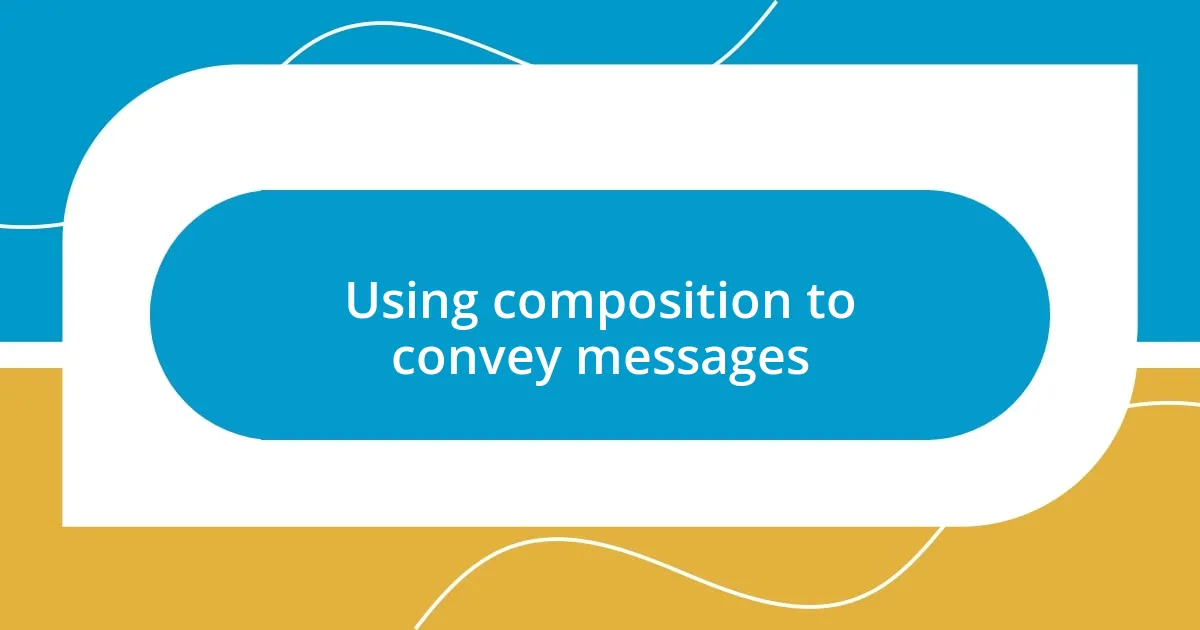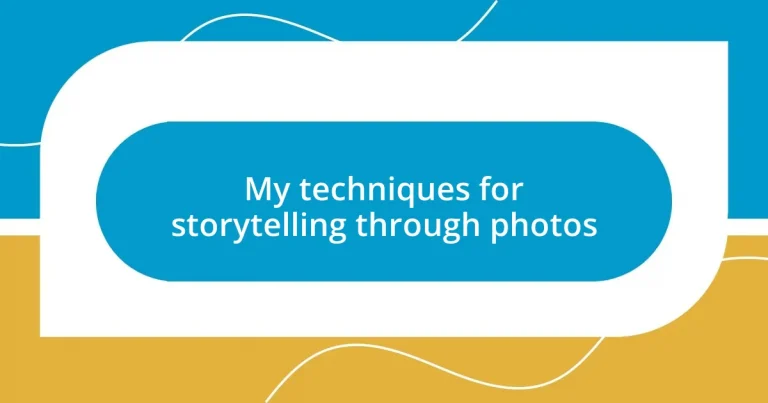Key takeaways:
- Storytelling through photography captures emotions and narratives that transcend mere visuals, creating connections that resonate universally.
- Choosing the right subject matter and engaging with the environment can evoke genuine feelings, enriching the narrative and viewer connection.
- Techniques like utilizing natural light, incorporating movement, and thoughtful editing can significantly enhance the emotional depth and storytelling of images.
- Composition elements, such as framing and leading lines, guide viewer interpretation and can alter the emotional impact of a photograph.

Understanding the power of storytelling
Storytelling holds an incredible power that resonates deeply with us all. I remember a particular photo I took during a family gathering; it captured my grandmother’s laughter as she held my niece. That single image told a complete story of joy and connection, evoking emotions that transcended words. Isn’t it fascinating how a single moment can encapsulate a lifetime of relationships?
When I think about the stories within my photographs, I realize they often encompass more than just a visual. Each image can carry layers of meaning—context, emotion, and even history. For instance, I have a photo of a weathered fisherman on a pier. His expression tells a lifetime of struggles, triumphs, and lessons learned. Doesn’t this make you ponder what untold stories linger behind images we encounter each day?
What I’ve come to understand is that storytelling through photos serves as a universal language, bridging the gaps between cultures and experiences. Every captured moment has the potential to touch someone’s heart or spark a memory. As I reflect on my own journey, I find myself asking: How can I convey the depth of human experience through just a snapshot? It’s this challenge that keeps me motivated to hone my storytelling skills.

Choosing the right subject matter
Choosing the right subject matter can truly make or break a photograph’s story. I’ve noticed that the most impactful images often stem from subjects that resonate with me personally. For example, one day, while wandering through a local market, I stumbled upon an elderly vendor passionately showcasing his handmade goods. The depth in his eyes and the stories etched on his face compelled me to capture that single moment. Have you ever felt drawn to photograph someone simply because their presence ignited a story within you?
When I think back on my photography journey, the subjects I chose often reflect my emotions and state of mind. On a rainy afternoon, I captured a lone child splashing through puddles, joy radiating despite the dreary weather. It was in that moment, I realized how powerful it is to focus on subjects that evoke genuine feelings. It makes me wonder: How can I find subjects that spark my emotions and tell stories worth sharing?
The key here is to engage with your surroundings and listen to the stories that beg to be told. Whether it’s a bustling city street or a quiet rural setting, I’ve learned that each subject can inspire a different narrative. For instance, I took a series of photos at a community event that highlighted diverse stories of unity and celebration. This variety of subjects not only enriches my portfolio but often leads to unexpected connections with viewers. Isn’t it amazing to discover that the right subject matter can resonate with others in ways we didn’t anticipate?
| Subject Matter | Impact |
|---|---|
| Natural Landscapes | Emphasizes tranquility and environmental connection |
| People and Emotions | Evokes empathy and personal stories |
| Candid Moments | Captures authenticity and spontaneity |
| Urban Scenes | Reflects societal dynamics and diversity |
| Cultural Events | Showcases heritage and communal bonds |

Building an emotional connection
Building an emotional connection in photography is truly an art form. I recall a moment during a festival when I captured a father’s proud gaze as he watched his daughter perform on stage. The raw emotion in that photograph still resonates with me; it’s as if their bond leapt off the frame and wrapped around my heart. This connection isn’t just about the subjects; it’s about what they evoke in us as viewers.
To strengthen this connection, I focus on specific techniques that amplify the emotional depth of my images:
- Use Natural Light: It softens skin tones and creates a warm atmosphere, enhancing emotions.
- Capture Eyes: The eyes can convey a world of feelings; my favorite images are often those where the subject’s gaze draws you in.
- Embrace Imperfection: The most touching moments are often those that are unplanned and raw, showcasing authentic emotions.
- Incorporate Movement: I love photos where movement tells a story, like a child running joyfully or an elderly couple dancing.
- Seek Out Unique Perspectives: A different angle or framing can unveil overlooked emotions, transforming a simple shot into a heartfelt narrative.
These techniques can transform a mere photograph into a portal of emotions, allowing the viewer to feel and connect with the stories behind the images.

Using composition to convey messages
When I compose an image, I often consider how the arrangement of elements can shape the viewer’s interpretation. For instance, I once captured a photo of a solitary tree standing tall on a windswept hill. By placing the tree off-center according to the rule of thirds, I felt that it not only highlighted its strength against the vast sky but also conveyed a sense of isolation. Have you noticed how the placement of objects within a frame can evoke different emotions?
Leading lines are another powerful way to guide the viewer’s eye and tell a story. In one of my urban photographs, I shot down a bustling street, using the lines of the road to draw attention to a busker playing music. The dynamic energy of the crowd surrounding him created a narrative of community and artistry, all because the composition directed focus effectively. How do you think the lines in your photos affect the stories they tell?
Framing the subject within natural elements can create intimacy and context, as I’ve experienced while photographing my daughter in our garden. I opted to use the blooming flowers as a frame around her cheerful face, which not only highlighted her joy but also tied the moment to the beauty of nature. This technique adds depth and layers to a photograph, showcasing the relationship between the subject and their environment. Have you tried using elements in your surroundings to enhance the message in your photographs?

Incorporating light and color
In my experience, light can significantly alter a photo’s mood and impact. During a sunrise shoot at my favorite beach, I learned how golden hour light transforms everything it touches. The way the soft, warm rays illuminated the sand and water created a serene, almost magical atmosphere. Have you ever noticed how a well-placed beam of light can elevate an ordinary shot to something extraordinary?
Color, too, plays a vital role in storytelling through photos. I remember a vibrant market in a remote village, bursting with shades of blue, red, and yellow. Each hue seemed to pulse with life, telling a story of culture and community. I sought to capture those colors in a way that reflected the joyful spirit of the people there. Have you considered how the palette in your photos can evoke specific feelings or memories?
Finding the right balance between light and color can also enhance the narrative. For example, while photographing a somber event, I chose to lean into cooler tones and low light. This created a serene yet poignant atmosphere that resonated with the emotions of the moment. It’s fascinating how light and color together can either uplift or deepen the emotional weight of an image, isn’t it?

Capturing movement and action
Capturing movement and action in photography can be both exhilarating and challenging. I recall a time when I tried to freeze the moment of my dog leaping into a pond. With a fast shutter speed, I caught the water spray glistening in the sunlight, and that vibrant energy made the image come alive. It’s amazing how a split second can convey the thrill of action, don’t you think?
Another technique I often utilize is panning, where I move the camera along with a subject in motion. I once photographed a cyclist racing past, and by keeping my camera in sync with their speed, I achieved a beautiful blur of the background that accentuated their swift movement. This approach adds a sense of action and urgency, almost as if the viewer can feel the rush of the moment. Have you experimented with motion blur in your own photography?
Sometimes, the best action shots capture candid moments rather than posed ones. I had a delightful experience at a children’s carnival, when I snapped a photo of a child mid-laugh, her hair flying back as she spun around. That spontaneous burst of joy encapsulated the spirit of the day perfectly. How often do we overlook these fleeting moments that tell powerful stories without any staging?

Editing for narrative enhancement
Editing photos for narrative enhancement is a critical skill I’ve developed over the years. I vividly recall a project where I was tasked with documenting a local festival. While the raw images were colorful and packed with energy, a quick edit to adjust contrast and saturation brought out the vibrant essence of the celebrations. Have you ever tweaked an image and felt it come alive in a way that echoed the emotions of the moment? That’s the power of editing.
One of my go-to techniques involves cropping to emphasize key elements in a scene. I remember capturing a street performer surrounded by a crowd, but the initial shot felt cluttered. By zooming in on the performer’s expressive face, the edited image became a compelling portrait that told a story of passion and connection with the audience. It made me realize how thoughtful cropping can direct attention and forge a stronger connection with the viewer. Isn’t it incredible how a simple adjustment can transform a photograph’s narrative?
Additionally, I often play with filters to establish a mood that resonates with the story I want to convey. For instance, while editing images from a rainy day shoot, I opted for a nostalgic black-and-white filter, which evoked a sense of longing and reflection. This choice not only enhanced the visuals but also deepened the emotional weight of the narrative. Do you think about mood when editing, and how that might alter the viewer’s experience of your photos? It’s such a rewarding aspect of storytelling!














